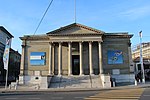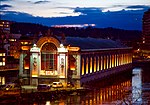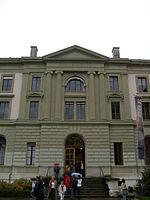Beth Yaakov Synagogue
Ashkenazi Jewish culture in SwitzerlandAshkenazi synagoguesBuildings and structures in GenevaByzantine Revival synagoguesEuropean synagogue stubs ... and 5 more
Moorish Revival synagoguesReligious buildings and structures in GenevaSwiss building and structure stubsSynagogues completed in 1859Synagogues in Switzerland

The Beth Yaakov Synagogue is located in the heart of the city of Geneva. It has also been known as the Grande Synagogue. It was built between 1858 and 1859 for the Ashkenazi Jewish community, which comprised about 200 people at the time of the synagogue's construction.
Excerpt from the Wikipedia article Beth Yaakov Synagogue (License: CC BY-SA 3.0, Authors, Images).Beth Yaakov Synagogue
Place de la Synagogue, Geneva Cité
Geographical coordinates (GPS) Address External links Nearby Places Show on map
Geographical coordinates (GPS)
| Latitude | Longitude |
|---|---|
| N 46.202777777778 ° | E 6.1408333333333 ° |
Address
Beth Yaacov
Place de la Synagogue 7
1204 Geneva, Cité
Geneva, Switzerland
Open on Google Maps







